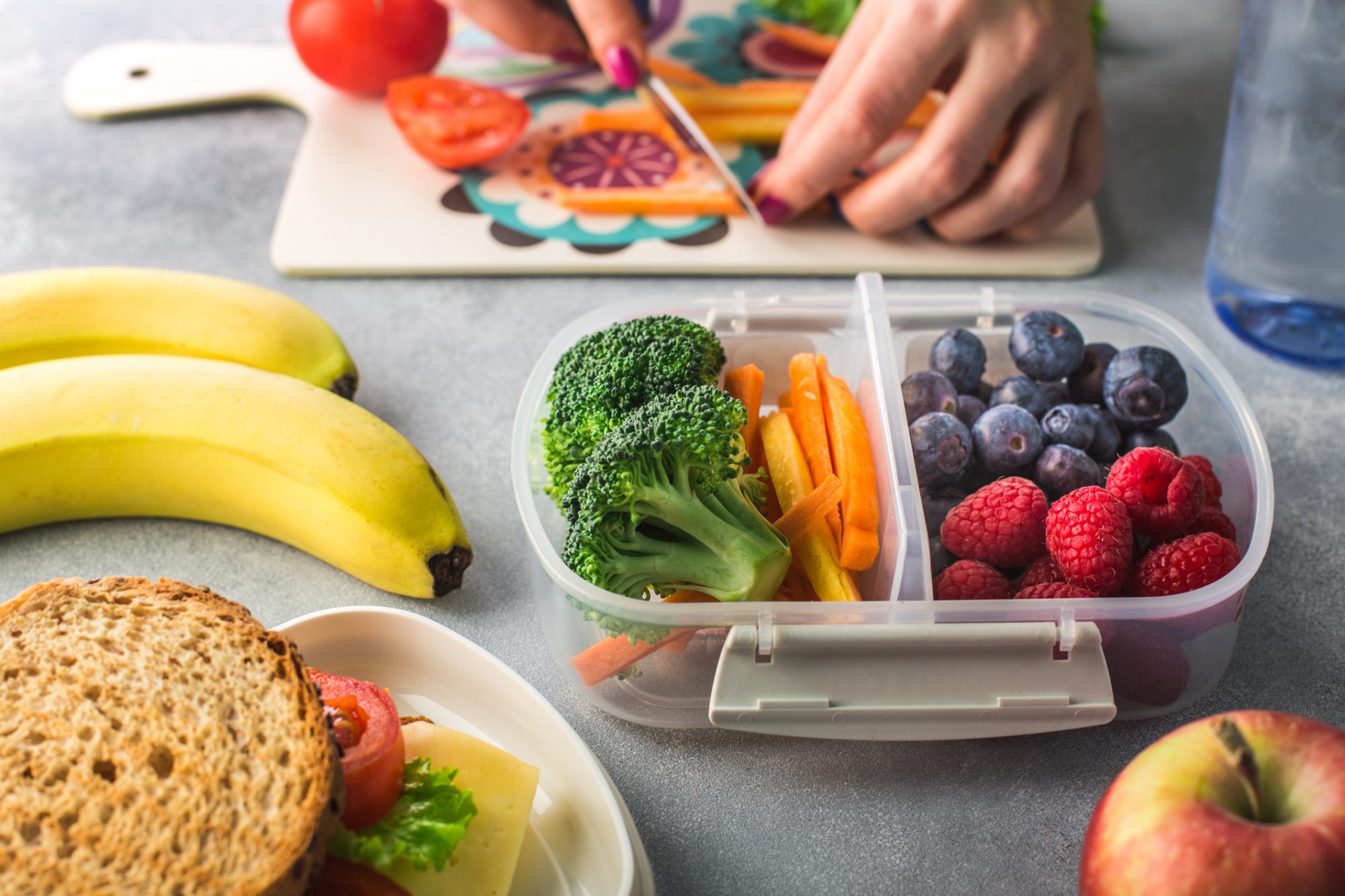As nearly any parent can attest, coming up with school lunch meals that your child will actually find appealing and have a remote shot at eating can be… challenging (understatement of the year). It's a problem that's often compounded when you're operating on a tight budget—or at the very least, trying not to actively waste money on spoiled, unwanted food.
To help with the task of creating affordable and appealing school lunches for your children, we asked moms, budget lifestyle experts, and dietitians to share some tips. Here's what they recommend when it comes to meal prep, snack ideas, and creating packed lunches for school.

Buy in bulk
This is a tried-and-true hack for countless parents. In fact, multiple experts suggested this tip (or some variation): When it comes to food items that won't spoil, such as dry snacks, buying in bulk can save a great deal of money.
"Costco is great for snacks. I love buying a big bag of popcorn and Tostitos at Costco, and adding those to my kid's lunches," Victoria Cornell, creator of the site Motherhood Life Balance, tells Parents. "It's very affordable, and I always have snacks on hand. Another favorite at Costco for school lunches is Goldfish crackers and Bear Paws. You get a ton of snacks for a great price."
Massachusetts mom Jennifer Weedon Palazzo, of MomCave TV, suggests always purchasing the "big option" when it comes to food your children like (beyond merely dry snacks). Doing so will almost always pay off financially.
"Don't buy cute snacks in individual packages. For instance, if your kid loves yogurt, buy the 32-ounce size instead of the individual Go-Gurts," Palazzo, mother to a 6-year-old and an 11-year-old, tells Parents. "Check the unit price and you'll see that you're saving a ton. Just spoon some into a small container and put it in the lunch box."
Send leftovers
For some kids, a PB and J simply won't cut it. If this sounds like your brood, save money on high-end meal prep by sending leftovers from home-cooked meals, suggests Michelle Keldgord, mother of two school-aged kids and co-founder of Baking How.
"My kids are fancy eaters. They don't want sandwiches in their lunch pails, and that's fine with me. I always send leftovers to school, and I know they will have a full belly of nutritious foods. Plus, it saves me money from having to make a separate lunch," Keldgord tells Parents.
Palazzo often relies on this approach as well, packing her children's lunches immediately after dinner each night.
"As you're cleaning up from dinner, you can see what leftovers you have that can be good for kids' lunches tomorrow," she explains. "Favorites in our house include pasta and chicken."
Batch-cook and freeze
In addition to the leftovers hack, you can also save money on school lunches by batch-cooking and freezing food, advises Rima Kleiner, a registered dietitian and for Dish on Fish.
"There are a lot of freeze-and-reheat recipes for breakfast and dinner, but not as much for lunch. However, it's just as easy to batch cook lunch items and freeze them for lunch," Kleiner tells Parents. "Some easy ideas include Easy Egg & Crab Muffins or Breakfast Shrimp Burritos. They're not just for breakfast, and they make it easy to help your kiddo meet the recommended to three seafood meals each week."
You might also try making and freezing some bean and cheese burritos, or turkey meatballs, says Kleiner. After cooking them, let the food cool, and then wrap, label, and freeze. When you need it, reheat the food for your children's lunchbox.
Invest in reusable lunch containers or bento boxes
This is a tip every household should adopt for so many reasons: Ditch the plastic baggies and other single-use plastic storage items that you buy over and over. Instead, invest in bento boxes or other reusable lunch containers. Doing so will save you money and cut down on environmentally harmful plastic waste. There are countless options these days that are kid-friendly.
Expert favorites include Klean Kanteen's steel lunch boxes and bento boxes, which are available in three handy sizes for everything from munchies to meals (prices start around $24.95). The boxes are 100 percent plastic-free, reusable, and leak-proof.
Better Basics also offers their own line of reusable back-to-school food containers, including an insulated stainless steel option designed to keep lunch foods (think: soups or chicken nuggets) warm or cool. Amazon also has dozens of bento box options for every price point including some starting at just $15.99.
While these lunch boxes may require an up-front investment, they'll be a money saver in the long run.
"I love bento boxes because it means no buying and tossing plastic baggies every day," registered dietitian Kaleigh McMordie, of Lively Table, tells Parents. "I also love them because you can add several different components to make a snack lunch with low-cost items such as fresh fruit or veggies, beans, edamame, cheese, crackers, and nuts without having to buy costly individual packs."
Go for pasta
What kid doesn't love pasta? Or at least macaroni and cheese? Don't overlook this type of food as a lunch option, says McMordie.
"It's a great affordable way to add more fiber, veggies, and even protein depending on the type," McMordie explains. "I love packing chicken or cheese tortellini with tomato sauce or whole wheat pasta with pesto and chicken."
Create homemade juice boxes
Juice boxes for school lunches are another cost you can easily eliminate with a little advance planning. To get started, purchase a reusable water bottle, says Keldgord, of Baking How.
"Then, buy a few packages of flavored powders. Add the powder and water to the reusable product. Viola! You have a homemade 'juice box' that is super cheap," says Keldgord.
Want to eliminate even more costs? Use natural flavor enhancers such as lemon, strawberry, cucumber, or anything your kids like, instead of the powder.
Make your own healthy snack mixes
Rather than constantly relying on brain- and energy-draining processed and ultra-processed snacks, try making your own healthier snack mixes, which can also be far cheaper, says Uma Naidoo, a Harvard-trained nutritional psychiatrist, professional chef, and author of the book This is Your Brain on Food.
"A simple nut and cacao nib mix [that will supply] two weeks of lunches can be tossed together with high-quality hazelnuts or macadamia nuts and cacao nibs, which are rich in brain-boosting cacao flavanols without added sugars," Naidoo tells Parents. "Stores like Trader Joe's offer natural organic nuts and organic cacao nibs at cost-effective prices—and remember, each daily portion is one quarter cup, so this will last for several lunches during the week."
Frozen fruits can be more cost-effective
Purchasing frozen berries can often be more financially savvy than buying fresh, suggests Naido.
"In the U.S., vegetables and fruit are flash-frozen at their peak, so snag those frozen wild blueberries when you can. Wild blueberries have twice the amount of brain-boosting antioxidants than regular berries, too," Naido explains. "Add blueberries to plain dairy or coconut yogurt, sweeten with cinnamon, and add to lunch boxes as a brain- and gut-boosting snack."
Stock up on healthy, kid-friendly snacks when there are sales
Carrot and celery sticks are among the few vegetables some (fussier) kids will eat. And when paired with a natural nut and seed butter, these foods can be a major health boost, says Naido.
"Nuts and seeds have healthy, short-chain Omega-3 fats for brain development, and are a less sugar-laden but sweet 'treat,'" she explains. "Save money by buying fresh carrots or celery when they are on sale, and cut up a batch of family-friendly sticks and store in the fridge for school lunches."
Yet another budget-friendly way to serve kids celery and carrots in their lunch is by pairing them with homemade hummus. "One can of organic chickpeas, rinsed and drained, can be easily made into a batch of hummus," continues Naido. "Add spices or flavors that your family enjoys, then portion out into one-quarter cup servings for school lunches. Add in extra veggies with chopped red bell peppers, which are rich in vitamin C too."
Meal-plan with your kids
As a parent, it can be easier to simply make executive decisions on your own when it comes to food shopping, purchases, and meal planning. But engaging your children in the process can be very useful, says Kleiner, of Dish on Fish.
"Getting your children involved in lunchtime planning can help you save money by reducing food waste," Kleiner says. "And remember: It doesn't have to be the whole meal… Maybe you decide on the main items but let them pick their own fruit or snack. This helps them develop kitchen confidence, and increases the likelihood that they'll actually eat what's packed, so less food and ultimately, less money is wasted."





